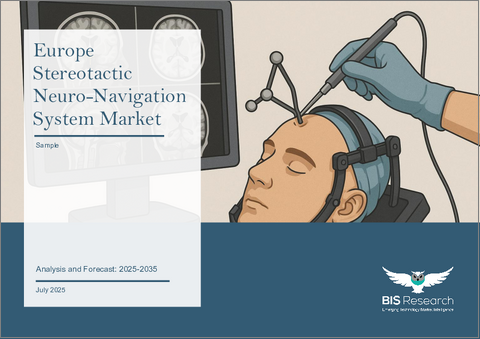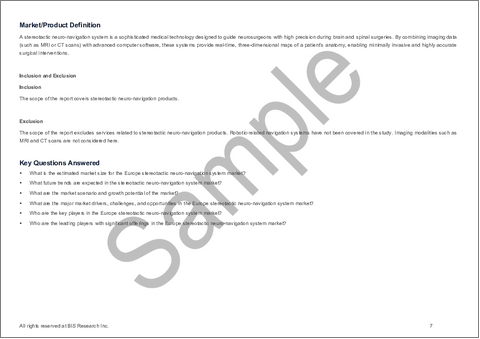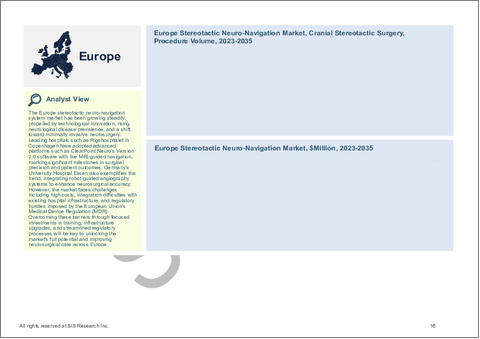|
|
市場調査レポート
商品コード
1781116
欧州の定位ニューロナビゲーションシステム市場:分析・予測 (2025-2035年)Europe Stereotactic Neuro-Navigation System Market: Analysis and Forecast, 2025-2035 |
||||||
カスタマイズ可能
|
|||||||
| 欧州の定位ニューロナビゲーションシステム市場:分析・予測 (2025-2035年) |
|
出版日: 2025年07月31日
発行: BIS Research
ページ情報: 英文 63 Pages
納期: 1~5営業日
|
全表示
- 概要
- 図表
- 目次
欧州の定位ニューロナビゲーションシステムの市場規模は、2024年の2億6,900万米ドルから、予測期間中はCAGR 13.14%で推移し、2035年には10億1,420万米ドルに成長すると予測されています。
神経疾患の有病率の増加と、従来の外科手術に比べてナビゲーション支援手術がもたらす明確な利点により、欧州の定位的ニューロナビゲーション業界は二桁成長を続けています。拡張現実 (AR)、機械学習、AIといった技術の進展により、これらのプラットフォームの活用範囲が広がり、手術の精度も向上しています。低侵襲手術への移行が進む中で、高精度なナビゲーション技術への需要は一層高まっています。さらに、高齢化の進行によって加齢に伴う神経疾患が増加していることも、市場拡大を支える要因の一つとなっています。
| 主要市場統計 | |
|---|---|
| 予測期間 | 2025-2035年 |
| 2025年評価 | 2億9,500万米ドル |
| 2035年予測 | 10億1,420万米ドル |
| CAGR | 13.14% |
高度なナビゲーションシステムの高コスト、既存のITおよび画像診断システムとの統合の難しさ、手術中のトラブルの可能性などが、導入の障壁となることがあります。それにもかかわらず、継続的な技術革新、EUの支援的な規制枠組み (MDRの簡素化ルートなど)、ニューロナビゲーション技術が脊椎手術や頭蓋顔面手術などの関連分野へと拡大していることにより、市場は今後も成長の勢いを保ち、欧州全域でさらなる拡大が期待されています。
欧州における定位的ニューロナビゲーションシステム市場は、低侵襲な処置や精密誘導による脳神経外科手術への需要の高まりにより、大きく成長すると見込まれています。これらのシステムは、リアルタイムの三次元解剖マッピングや手術経路のプランニングを提供するため、脳深部刺激療法、腫瘍生検、てんかん手術、機能的脳神経外科などにおいてますます注目されています。また、この地域では高齢化が進み、てんかん、脳腫瘍、パーキンソン病などの神経疾患の有病率が上昇していることから、病院は手術リスクを低減し、患者の転帰を改善する高度なナビゲーションシステムへの投資を進めています。
技術革新も市場の拡大を牽引しています。拡張現実 (AR) によるオーバーレイ表示、AIによる手術計画アルゴリズム、術中MRI/CTスキャナとのシームレスな統合により、手術精度とワークフロー効率が向上しています。また、クラウドベースの症例管理や遠隔協業技術も普及しつつあり、複数の医療施設間での専門知識の共有や術前準備の迅速化が可能になっています。さらに、西欧州における好意的な償還制度や、東欧州での医療支出の増加も導入の追い風となっています。
しかし、依然として導入における障壁は存在します。特に中小規模の地域病院では、初期導入費用やソフトウェアライセンス料の高さ、既存の画像診断装置や病院ITシステムとの複雑な統合、外科医に対する高度なトレーニングの必要性が、普及の妨げとなる可能性があります。また、EU医療機器規則 (MDR) への厳格な対応が、時間とコストの負担を増加させています。将来的には、医療機器メーカー、学術機関、医療機関の間での研究開発パートナーシップの継続や、システム間の相互運用性を標準化する取り組みによって、臨床応用の幅がさらに広がり、市場は安定的な成長を遂げていくと予想されます。
市場の分類:
セグメンテーション1:地域別
- 欧州
- ドイツ
- 英国
- フランス
- その他
当レポートでは、欧州の定位ニューロナビゲーションシステムの市場を調査し、主要動向、市場影響因子の分析、法規制環境、技術・特許の分析、市場規模の推移・予測、各種区分・地域/主要国別の詳細分析、競合情勢、主要企業のプロファイルなどをまとめています。
目次
エグゼクティブサマリー
範囲と定義
第1章 市場:業界展望
- 市場動向
- シナジー効果を活用した事業ポートフォリオの多様化
- 償還シナリオ
- 規制状況/コンプライアンス
- 欧州
- サプライチェーン分析
- 価格分析
- 市場力学
- 市場促進要因
- 市場抑制要因
- 市場機会
第2章 定位ニューロナビゲーションシステム市場:地域別
- 欧州
- 地域概要
- 市場成長の原動力
- 市場課題
- 英国
- ドイツ
- フランス
- その他
第3章 市場:競合ベンチマーキングと企業プロファイル
- 主要戦略と開発
- 製品ベンチマーク
- 市場シェア
- 企業プロファイル
- Medtronic Plc
- Brainlab AG
- Elekta
第4章 調査手法
List of Figures
- Figure 1: Europe Stereotactic Neuro-Navigation System Market (by Scenario), $Million, 2025, 2029, and 2035
- Figure 2: Stereotactic Neuro-Navigation System Market, $Million, 2024 and 2035
- Figure 3: EU Classification
- Figure 4: NHS Classification
- Figure 5: Supply Chain and Risks within the Supply Chain
- Figure 6: Prevalence of Parkinson's Disease (by Region), 2016-2021
- Figure 7: Increasing Incidence of CNS Brain Tumor Cases (by Region), 2022, 2025, 2035, and 2045
- Figure 8: Increasing Aging Population Globally, Million, 2020-2023
- Figure 9: Europe Stereotactic Neuro-Navigation Market, Spinal Navigation Surgery, Procedure Volume, Thousands, 2023-2035
- Figure 10: Europe Stereotactic Neuro-Navigation Market, Cranial Stereotactic Surgery, Procedure Volume, Thousands, 2023-2035
- Figure 11: Europe Stereotactic Neuro-Navigation Market, $Million, 2023-2035
- Figure 12: Incidences of Neurological Disorders in U.K., Million, 2018-2021
- Figure 13: U.K. Stereotactic Neuro-Navigation System Market, $Million, 2023-2035
- Figure 14: Incidences of Neurological Disorders in Germany, Million, 2018-2021
- Figure 15: Germany Stereotactic Neuro-Navigation System Market, $Million, 2023-2035
- Figure 16: Incidences of Neurological Disorders in France, Million, 2018-2021
- Figure 17: France Stereotactic Neuro-Navigation System Market, $Million, 2023-2035
- Figure 18: Incidences of Neurological Disorders in Rest-of-Europe, Million, 2018-2021
- Figure 19: Rest-of-Europe Stereotactic Neuro-Navigation System Market, $Million, 2023-2035
- Figure 20: Strategic Initiatives, January 2017-May 2025
- Figure 21: Data Triangulation
- Figure 22: Top-Down and Bottom-Up Approach
- Figure 23: Assumptions and Limitations
List of Tables
- Table 1: Market Snapshot
- Table 2: Competitive Landscape Snapshot
- Table 3: Some of the Key Developments
- Table 4: CPT Coding
- Table 5: Inpatient Reimbursement
- Table 6: Price of Stereotactic Neuro-Navigation System
- Table 7: Drivers, Restraints, and Opportunities: Current and Future Impact Assessment
- Table 8: Comparison between Various Navigation-Assisted Surgeries Over Conventional Surgeries
- Table 9: Sources of Error in Navigated Surgery
- Table 10: Cost of Acquisition of Key Neuro-Navigation Systems
- Table 11: Stereotactic Neuro-Navigation System Market (by Region), $Million, 2023-2035
- Table 12: U.K. Incidences of Neurological Disorders, By Disease Type, 2018-2021
- Table 13: Germany Incidences of Neurological Disorders, By Disease Type, 2018-2020
- Table 14: France Incidences of Neurological Disorders, By Disease Type, 2018-2020
- Table 15: Rest-of-Europe Incidences of Neurological Disorders, By Disease Type, 2018-2020
- Table 16: Some of the Strategies and Development, January 2017-May 2025
- Table 17: Europe Stereotactic Neuro-Navigation System Market, Product Benchmarking (by Product)
- Table 18: Market Share Analysis, 2024
This report can be delivered in 2 working days.
Introduction to Europe Stereotactic Neuro-Navigation System Market
The Europe stereotactic neuro-navigation system market is projected to reach $1,014.2 million by 2035 from $269.0 million in 2024, growing at a CAGR of 13.14% during the forecast period 2025-2035. The growing prevalence of neurological illnesses and the obvious benefits of navigation-assisted operations over traditional surgery have been driving double-digit growth in the stereotactic neuro-navigation industry in Europe. Advancements like augmented reality, machine learning, and artificial intelligence are expanding the use of these platforms and improving surgical accuracy. There is now a greater need for high-precision navigation technologies due to the move towards less intrusive procedures. Another factor supporting market expansion is an ageing population, which is contributing to an increase in age-related neurological diseases.
| KEY MARKET STATISTICS | |
|---|---|
| Forecast Period | 2025 - 2035 |
| 2025 Evaluation | $295.0 Million |
| 2035 Forecast | $1,014.2 Million |
| CAGR | 13.14% |
The high cost of sophisticated navigation systems, the difficulty of integrating them with current IT and imaging systems, and the possibility of intraoperative problems, however, can all be barriers to adoption. Notwithstanding these obstacles, continued technological advancements, pro-EU regulatory frameworks (such as streamlined MDR pathways), and the expansion of neuro-navigation into related specialities like spinal and craniofacial surgery are expected to maintain momentum and spur additional expansion throughout Europe.
Market Introduction
The market for stereotactic neuro-navigation systems in Europe is expected to develop significantly due to the rising demand for minimally invasive interventions and precision-guided neurosurgery procedures. These systems are becoming more and more popular for deep brain stimulation, tumour biopsies, epilepsy surgeries, and functional neurosurgery because they offer real-time, three-dimensional anatomical mapping and trajectory planning. Because of the region's ageing population and increased prevalence of neurological conditions including epilepsy, brain tumours, and Parkinson's disease, hospitals are investing in cutting-edge navigation systems that lower operating risks and enhance patient outcomes.
Technological advancements are driving market expansion: augmented reality overlays, AI-powered planning algorithms, and smooth integration with intraoperative MRI/CT scanners are improving surgical precision and workflow effectiveness. Cloud-based case management and remote collaboration technologies are also becoming more popular since they facilitate the sharing of expertise across many sites and expedite preoperative preparation. Adoption is also being aided by favourable reimbursement practices in Western Europe and rising healthcare spending in Eastern Europe.
Adoption obstacles still exist, though. Uptake may be slowed, particularly in smaller community hospitals, by high acquisition and software-licensing costs, complicated integration with legacy imaging and hospital IT systems, and the requirement for intensive surgeon training. Time and expense are increased by strict adherence to the EU Medical Device Regulation. In the future, it is anticipated that continued research and development partnerships among device makers, academic institutions, and healthcare providers-as well as initiatives to standardise interoperability-will expand clinical applications and propel steady expansion throughout the European stereotactic neuro-navigation market.
Market Segmentation:
Segmentation 1: by Region
- Europe
- Germany
- U.K.
- France
- Rest-of-Europe
Europe Stereotactic Neuro-Navigation System Market Trends, Drivers and Challenges
Market Trends
- Rising adoption of frameless, image-guided navigation systems offering enhanced ergonomics and workflow integration
- Integration with intraoperative MRI/CT and augmented reality for real-time anatomical visualization
- AI-driven planning tools that automate trajectory optimization and risk assessment
- Cloud-based platforms enabling multi-site data sharing and remote surgical planning
- Hybrid OR deployments combining neuro-navigation with robotics for end-to-end precision
Key Drivers
- Growing incidence of brain tumors, movement disorders, and epilepsy fueling demand for precise surgical guidance
- Shift toward minimally invasive neurosurgical techniques to reduce patient morbidity and hospitalization
- Increased healthcare spending and favorable reimbursement policies across Western and Eastern Europe
- Collaboration between device manufacturers and leading academic centers accelerating clinical validation
- Need for streamlined workflows to boost OR efficiency and reduce procedure times
Major Challenges
- High capital and recurring software-license costs limiting uptake in smaller hospitals
- Complex integration with legacy imaging equipment and hospital IT systems
- Steep learning curve for surgeons and OR staff requiring dedicated training programs
- Evolving EU MDR requirements prolonging time to market and increasing compliance costs
- Data-security and patient-privacy concerns around cloud-based case storage and analytics
Key Market Players and Competition Synopsis
The companies profiled have been selected based on inputs gathered from primary experts and an analysis of company coverage, product portfolio, and market penetration.
Some prominent names established in this market are:
- Medtronic Plc
- Brainlab AG
- Elekta
Table of Contents
Executive Summary
Scope and Definition
1 Market: Industry Outlook
- 1.1 Market Trends
- 1.1.1 Leveraging Synergies to Diversify Business Portfolio
- 1.2 Reimbursement Scenario
- 1.3 Regulatory Landscape/Compliance
- 1.3.1 Europe
- 1.3.1.1 U.K.
- 1.3.1 Europe
- 1.4 Supply Chain Analysis
- 1.5 Pricing Analysis
- 1.6 Market Dynamics
- 1.6.1 Market Drivers
- 1.6.1.1 Rising Prevalence of Neurological Disorders
- 1.6.1.2 Benefits Offered by Navigation-Assisted Surgeries Over Conventional Surgeries
- 1.6.2 Market Restraints
- 1.6.2.1 Complications Associated with the Use of Navigation Systems
- 1.6.2.2 High Cost of Acquisition
- 1.6.3 Market Opportunities
- 1.6.3.1 Integration of Artificial Intelligence (AI) and Machine Learning
- 1.6.1 Market Drivers
2 Stereotactic Neuro-navigation System Market (By Region), $Million, 2023-2035
- 2.1 Europe
- 2.1.1 Regional Overview
- 2.1.2 Driving Factors for Market Growth
- 2.1.3 Factors Challenging the Market
- 2.1.4 U.K.
- 2.1.5 Germany
- 2.1.6 France
- 2.1.7 Rest of the Europe
3 Markets - Competitive Benchmarking & Company Profiles
- 3.1 Key Strategies and Development
- 3.2 Product Benchmarking
- 3.3 Market Share
- 3.4 Company Profiles
- 3.4.1 Medtronic Plc
- 3.4.1.1 Overview
- 3.4.1.2 Top Products/Product Portfolio
- 3.4.1.3 Top Competitors
- 3.4.1.4 Target Customers
- 3.4.1.5 Key Personal
- 3.4.1.6 Analyst View
- 3.4.2 Brainlab AG
- 3.4.2.1 Overview
- 3.4.2.2 Top Products/Product Portfolio
- 3.4.2.3 Top Competitors
- 3.4.2.4 Target Customers
- 3.4.2.5 Key Personal
- 3.4.2.6 Analyst View
- 3.4.3 Elekta
- 3.4.3.1 Overview
- 3.4.3.2 Top Products/Product Portfolio
- 3.4.3.3 Top Competitors
- 3.4.3.4 Target Customers
- 3.4.3.5 Key Personal
- 3.4.3.6 Analyst View
- 3.4.1 Medtronic Plc
4 Research Methodology
- 4.1 Data Sources
- 4.1.1 Primary Data Sources
- 4.1.2 Secondary Data Sources
- 4.1.3 Data Triangulation
- 4.2 Market Estimation and Forecast





